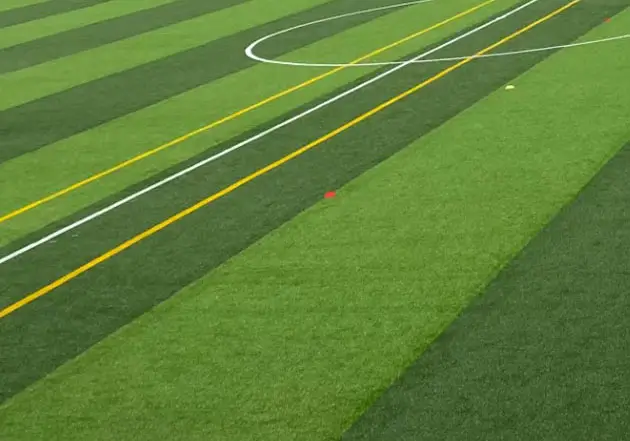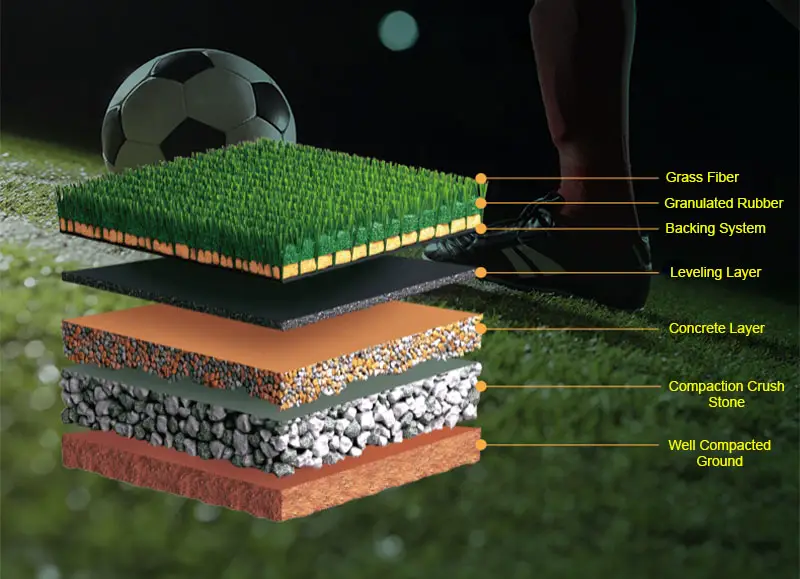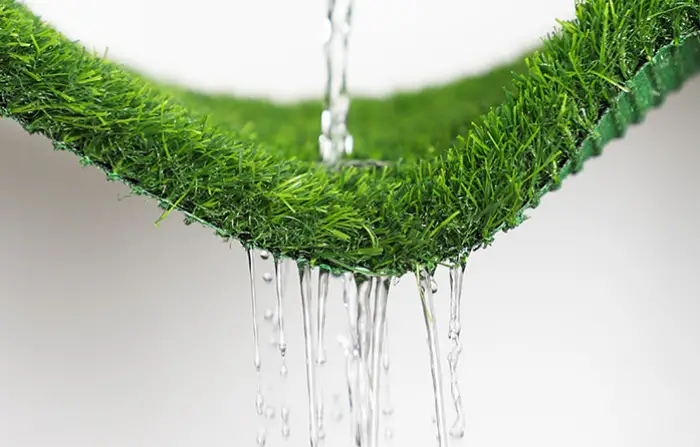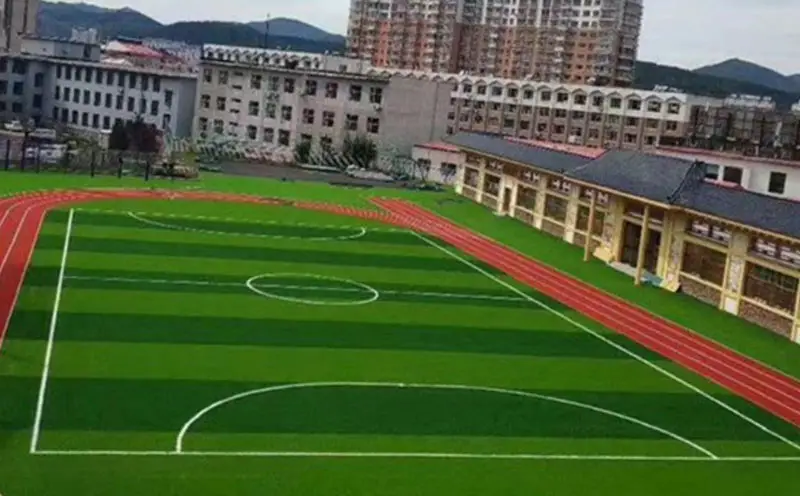The development of artificial pitches has been a revolutionary advancement in the world of sports. From humble beginnings, these surfaces have grown to become more than just a necessary component of many top-level athletic events – they’ve become an integral part of our culture and identity as athletes. We all share a subconscious desire for inclusion and belonging, which is why we feel so strongly about the ways that artificial turf has changed the game over time.
For decades now, synthetic fields have revolutionized athletics from the highest levels all the way down to local communities. What started out as simple solutions to poor conditions quickly evolved into modern marvels capable of withstanding even intense wear and tear without sacrificing safety or performance. With advances in technology came better materials, tighter stitching, improved drainage systems, and other features that made them increasingly attractive options for sporting events worldwide.
Today, there are dozens if not hundreds of different types of artificial pitches available depending on your needs. Whether you’re looking for something designed specifically for professional soccer matches or just want something reliable enough to practice football drills on after school, there’s no shortage of options when it comes to choosing a surface best suited for your particular sport. It’s easy to see why these versatile solutions have gained such widespread popularity throughout the years – and why they continue to be relied upon by millions around the globe today!
Why Is A Sports Field Called The Pitch?
The pitch is a term used for the playing field in many sports, including football, rugby, and cricket. It’s an interesting name with a complex history behind it. So why do we call it a ‘pitch’?
Well, there are several theories as to where the term originated from. One of the most popular suggestions is that it comes from an old English word that means ‘to throw’. This makes sense when you consider how most ball games involve passing or throwing the ball around. Another source suggests that ‘pitch’ is derived from the French phrase “pieds-de-chaise” meaning “feet of chairs” – referring to a type of game played on a level surface without any furniture obstructing play.
Other explanations point out that the word was also used by sailors who would often have to pass objects between ships at sea; therefore, their use of this terminology has been adopted over time by other sports people too. All these ideas come together to form our modern understanding of what a pitch stands for: an even space free from obstacles where sport can be enjoyed collectively amongst friends and family alike. The idea of community spirit and camaraderie within sports continues today – making it clear why pitches hold such importance in our lives.
History Of Artificial Pitch Surfaces
While the concept of an artificial pitch may sound like a modern innovation, they have been around since the 1950s. In fact, some may be surprised to learn that synthetic turf first found its way onto athletic fields in 1965, when it was installed at the Houston Astrodome for Major League Baseball (MLB). Since then, these surfaces have come a long way – both in terms of technological advancements and public acceptance.
Despite initial reservations about replacing natural grass on sports pitches with plastic alternatives, there are now many compelling reasons why this has become commonplace:
- Artificial pitches last longer than traditional ones because they require less maintenance over time;
- They can provide more consistent playing conditions throughout the year;
- Synthetic turf also eliminates mud and divots which would otherwise need to be filled regularly as part of routine ground care.
Artificial turf is not only widely used by professional athletes, but also across all levels of sport – from high school teams to recreational players. This is largely due to advances in technology that make such surfaces safer, easier to maintain, and more cost-effective than ever before. Ultimately, artificial pitches should be seen as just another tool available to coaches and groundskeepers who want their teams to play on a consistent surface day after day.
Types Of Synthetic Turf
When it comes to artificial pitches, the type of synthetic turf used can have a huge impact on the overall performance. There are several different types of synthetic turf available, each with its own unique characteristics. The first type is sand-filled turf, which consists of an infill made from fine sand particles and has been designed specifically for ball sports like football and rugby. This type of pitch offers great shock absorption and allows players to move around quickly without any risk of slipping or sliding.
The second type is rubber crumb turf, which uses small pieces of recycled rubber as the infill material instead of sand. This kind of turf provides superior traction for players and also helps reduce noise levels during games or training sessions. Additionally, rubber crumb turf requires less maintenance than sand-filled surfaces since the rubber does not need to be replaced regularly due to wear and tear.
Finally, there is hybrid grass, which combines natural grass with synthetic fibers for enhanced durability and cushioning. Hybrid grass provides excellent grip in wet conditions and gives a more realistic feel compared to other types of artificial pitches. It’s ideal for clubs that want a surface that looks natural but still offers top-notch performance qualities. These are just some examples among many when it comes to choosing the right synthetic turf for your facility – all offering their own benefits depending on what you’re looking for! As we transition into discussing installation processes next, one thing remains clear: understanding the various options available will ensure you make a well informed decision about your artificial pitch needs.
Installation Processes
The installation of artificial pitches has come a long way over the years. Initially, there was some trepidation about installing such surfaces due to their cost and perceived inferiority to grass. However, with advances in technology and materials, these fears have been quelled as artificial turf is now considered superior in many ways.
The first step in any successful installation process involves selecting an appropriate location. Taking into consideration factors like available space, terrain grade, drainage requirements, surface type, and even surrounding buildings are all important considerations when deciding where to place an artificial pitch. Once this is determined, a qualified installer must be consulted for advice on how best to lay down the sub-base layers that provide stability and cushioning for the playing surface itself.
Finally, modern synthetic turf systems offer a multitude of design options that make them ideal for nearly any situation or environment. In addition to being aesthetically pleasing, they can also reduce maintenance costs significantly while providing unbeatable performance characteristics throughout their lifetime. With so much versatility and quality available today, it’s no surprise why so many people opt for synthetic turf solutions over natural grass alternatives.
With careful attention paid during the planning stage and sound technical expertise applied during construction, a properly installed artificial pitch will serve its users well for years to come – thus making maintenance requirements far easier to manage than if regular grass had been chosen instead.
Maintenance Requirements
Having discussed the installation process of artificial pitches, it is now time to move on to maintenance requirements. For any pitch, whether natural or synthetic, regular upkeep and care are essential for longevity and playability. Artificial surfaces need even more attention due to their unique construction and design features. Here we will look at what needs to be done in order to maintain a safe and reliable playing surface:
Regular Cleaning:
- Sweep away debris regularly with a brush or blower.
- Use specialist cleaning agents occasionally if necessary.
Repairs & Replacing Damaged Areas:
- Replace worn-out turf as soon as possible.
- Take extra care when carrying out repairs so that you don’t damage the underlying base layer beneath the turf.
Finally, artificial pitches should be inspected regularly by qualified professionals who can identify potential problems before they become serious issues. This proactive approach helps ensure that your pitch remains to perform optimally year after year, giving players an enjoyable experience every time they step onto the field. With diligent maintenance and proper care, your pitch will remain an integral part of your team’s success for many years to come – transitioning seamlessly into our next topic about cost considerations!
Cost Considerations
How much does it typically cost to put in a synthetic field? When debating whether or not to purchase a synthetic field, this is the question on everyone’s mind. Several factors, including the type of turf being used and the size of the area needing coverage, will greatly affect the price of installation and maintenance of these surfaces. Furthermore, the price should account for any optional extras that the client may want.
Fortunately, many synthetic fields are built to last. Most can be used for up to 15 years before serious maintenance is required or replacement is necessary. The 8-10 year warranties offered by many manufacturers give customers confidence that their money will be protected in the event of a breakdown.
In light of this, it could be more cost-effective in the long run to maintain artificial turf than natural grass fields. Investment in an artificial pitch may provide better performance benefits than its natural counterpart, making it worth serious consideration for those looking for a longer-lasting solution, and this is despite the fact that the question of which option offers the best value for money is still up for debate.
2G Sport Pitch
A 2G sports pitch is a type of artificial grass surface that has been in use since the early 2000s. It is popularly used for a variety of sporting activities, such as football and rugby, but also less traditional sports like beach volleyball. This type of turf offers an excellent playing experience with its soft yet durable synthetic fibers which are designed to provide maximum shock absorption and grip on the ball during play. The sand infill helps cushion players’ falls while simultaneously providing stability to the surface. Additionally, this kind of field requires minimal maintenance due to its durability and low water consumption.
The main advantages of using a 2G sports pitch over natural grass include improved performance levels, cost-effectiveness, and versatility. Firstly, it provides athletes with increased speed and agility as there is no need to worry about divots or mud patches from rainwater on the field. Secondly, it can be installed quickly at any time without needing extensive ground preparation work associated with natural pitches – making it ideal for clubs who want their fields up and ready within days rather than weeks or months. Finally, these types of surfaces can be adapted for different uses by adjusting the amount of infill used – allowing them to easily host multiple games throughout the year without having to replace them each season.
2G sports pitches represent a reliable solution for clubs looking to reduce costs whilst still achieving superior playing conditions that rival those offered by natural surfaces. With greater safety considerations taken into account alongside enhanced player performances thanks to these kinds of surfaces, they have become increasingly popular amongst professional teams all around the world in recent years.
3G Sport Pitch
It’s hard to believe that artificial pitches have been around for decades. Who could forget the days when a makeshift pitch was just a patch of grass, mud, and stones? But times have changed, and today we can enjoy playing sports on state-of-the-art 3G sport pitches!
So what is a 3G sport pitch exactly? Well, here are some key features:
* 3G surfaces consist of synthetic fibers that are designed to simulate natural turf without the need for maintenance or watering.
* They are installed over a shock pad base which helps reduce impact injuries as well as improve ball control and bounce.
* The surface also provides excellent drainage during wet weather conditions.
These amazing qualities make 3G sport pitches an ideal choice for any sporting activity, whether it be football, rugby, or hockey. Not only do they provide players with an optimal playing experience but they are also great for hosting tournaments and conducting training sessions. With their low maintenance requirements and durable design, these types of pitches offer many advantages over traditional surfaces. And because they come in different designs and colors, you’re sure to find one that suits your needs perfectly!
The development of 3G sport pitches has revolutionized the way people play sports – making them more enjoyable while providing greater safety benefits compared to other type of surfaces. It’s no wonder why so many athletes choose this option whenever possible.
4G Sport Pitch
The fourth generation of artificial sports pitches, known as 4G, has revolutionized the way we play sports. It’s designed to provide players with a much more realistic and enjoyable playing surface than ever before. This is because it uses synthetic turf fibers that are made from recycled materials such as nylon or polypropylene, making it both durable and environmentally friendly. The pitch also features an underlay system which helps to cushion falls and reduce injuries. As a result, teams can enjoy higher levels of performance due to improved footing on the field.
4G technology also allows for regular maintenance without any downtime for the pitch itself. This includes brushing off debris, cleaning up after use, adding fresh infill material when needed, and applying specialized coatings specifically designed for artificial surfaces. All these processes ensure that the playing surface remains in an optimal condition at all times so that athletes can perform their best without worrying about slipping or tearing turf fibers.
Not only does 4G create better conditions for sports enthusiasts but its superior construction also makes it suitable for other activities such as yoga classes and exercise boot camps too! With 4G technology providing consistent quality throughout each season, no matter how intense things get on the field – you can always be sure that your team will have a safe and reliable playing surface ready when they need it most.
5G Sport Pitch
In the age of digital transformation, sports pitches have also evolved with increasing technology. 5G sport pitches are the newest development in artificial turf fields and offer unparalleled performance capabilities for athletes. These high-tech surfaces bring together state-of-the-art materials and designs to create a safe, durable surface that is perfect for any level of athlete or competition.
The most innovative feature of 5G sport pitches is their ability to adapt to changing weather conditions while still delivering optimal playing characteristics. This makes them an ideal choice for outdoor venues which can experience extreme temperatures as well as heavy rainfalls. The pitch also has improved drainage capabilities allowing water to quickly disperse without compromising its structural integrity – providing athletes with more consistent footing even during wetter periods.
5G sport pitches are designed to reduce injuries due to hard landings and other impact related issues caused by poor quality surfaces. By using advanced shock absorption technologies, these surfaces provide cushioning support where it’s needed most – around the feet and ankles – resulting in fewer long term problems associated with traditional grass fields. With this added layer of protection, players can safely practice or compete at top levels on a reliable surface that won’t wear down over time as natural grass does.
Whether you’re looking for a new field for professional teams or recreational leagues, 5G sport pitches deliver superior playing experiences in all types of weather conditions. From tournaments to training sessions and everything in between – there’s no better way to ensure your team stays ahead of the game than investing in one of these revolutionary surfaces.
Environmental Considerations
Concern over the environmental impact of artificial pitches has grown in tandem with their rising popularity. Sustainable materials in these surfaces have been called into question as technology improves and more products are made for them. The question of whether or not they should be allowed to completely replace natural grass fields is also being discussed.
Polyethylene plastic, the material most commonly used on artificial pitches, can damage soil quality if it leaks into the surrounding area and leaches chemicals like lead and chromium into nearby water sources. This emphasizes the significance of routine cleaning of built-up debris and the replacement of worn components in order to ensure the longevity of such surfaces. Furthermore, some modern technologies have greatly diminished the quantity of energy needed to keep these surfaces operational, making them much more eco-friendly than conventional turf systems.
Air pollution caused by dust particles kicked up during play is another problem associated with the use of artificial pitches. Even though this dust may not appear to be a major issue at first, research has shown that athletes who are exposed to high levels of airborne dust particles for extended periods of time may experience health issues. That’s why it’s crucial to take preventative measures, like putting up barriers around the field or using water-based solutions to cut down on dust during play.
Each of these factors is important to think about when weighing the pros and cons of using artificial fields for sports. Moving forward, teams will need to address player safety concerns before determining whether or not artificial surfaces are right for them.
Player Safety Concerns
In the past decade, more and more athletes have been playing on synthetic turf fields. According to a recent study, over 95% of professional football teams now use artificial surfaces as their primary field choice. But with this increased popularity comes some safety concerns that need to be addressed.
The first concern is surface hardness. The hardness of an artificial field can vary greatly depending on its composition and construction. Some types of synthetic turf are harder than others and can cause a greater impact when players fall or collide during play. This can lead to serious injuries such as concussion and head trauma in contact sports like soccer and hockey. To combat this issue, many manufacturers offer softer versions of their turf that reduce the player’s risk for traumatic injury.
Another important factor is shock absorption. Synthetic turf tends to absorb less shock than natural grass due to its lack of resilience from compaction or wear down after heavy usage. When players land on hard surfaces they experience higher levels of force which increases the likelihood of injury occurring during sports activities. As a result, modern synthetic pitches come equipped with specialized padding systems underneath the surface which help protect athletes against potential shocks caused by impact or falls during gameplay.
These safety considerations are essential for protecting athletes who play on artificial pitches every day around the world. With continued innovation in synthetic turf technology, we can look forward to even safer surfaces for players at all levels of competition in years to come.
Innovation In Synthetic Turf Technology
The development of artificial pitches has come a long way since their introduction in the 1960s. Synthetic turf technology is constantly evolving, with new materials and designs being developed to meet the needs of players and coaches alike. Manufacturers have worked hard to create synthetic surfaces that replicate natural grass as closely as possible while providing improved performance capabilities.
A key innovation in recent years has been the use of infill systems which help maintain surface stability and provide cushioning for athletes. Infill systems are made up of small granules or fibers that fill the gaps between turf blades, creating an even playing surface. This helps reduce the impact on joints and prevents injuries from occurring during play. Other advances include rubberized shock pads which offer better traction, drainage improvements, and enhanced durability – all important features for modern sports pitches.
Innovations like these have revolutionized the industry and enabled more people than ever before to enjoy sports safely and comfortably on artificial surfaces around the world. The result: a global impact on the industry with more opportunities for enjoyment, competition, and growth. With such breakthroughs driving forward progress in synthetic turf technology, exciting possibilities await those who choose to embrace them.
Global Impact On The Industry
The exponential growth of artificial pitches over the years has made the trend a worldwide phenomenon. Athletes of every stripe are flocking to the sector, drawn by the promise of synthetic turf’s many benefits. There has been an increase in the number of countries investing in synthetic fields for use in sports training as officials there realize the benefits they can provide. As a result of this boom in demand, synthetic turf manufacturers have developed new techniques and ramped up their output.
The global sports industry has been profoundly affected by this sudden increase in interest. Increases in economies of scale have made it possible for companies to produce artificial pitches at lower costs while maintaining quality levels comparable to those found on natural grass surfaces, allowing them to compete on a wider scale. Since many nations now have access to synthetic fields for use in international competitions, attendance at games has increased and the sport’s popularity has been bolstered.
There is no doubt that artificial pitches have revolutionized the way we think about sports facilities today. They offer improved safety features like shock absorbency and reduced risk of injuries, improved gameplay through softer fields, and cost savings associated with installation and maintenance. This trend is expected to persist into the foreseeable future, as rising consumer demand is fueling further development of synthetic turf technology. This means that artificial fields are here to stay, and they will usher in some exciting new developments for players and fans alike.
Future Outlook
We can expect great things from synthetic fields in the future. Modern technology has made it possible for more advanced playing surfaces to be made. These surfaces are meant to be more realistic and last longer than ever before. Thus, when taking to the field on an artificial pitch, players can experience the game as closely as possible to the way it is played on natural grass.
Companies can make better use of their resources to create high-quality surfaces because there is now a much larger market for such products due to the growing demand for sports venues around the world. Recent studies have shown that artificial pitches are easier to take care of than natural grass courts. This makes them a good choice for many clubs and organizations.
Since artificial pitches have already improved in terms of safety, performance, player satisfaction, and cost-effectiveness, it only stands to reason that they will continue to do so in the years to come. All parties involved, from players to spectators, stand to gain from these developments. May the future bring us even more memorable moments played out on synthetic turf.
Conclusion
This number shows how common it is for sports teams, organizations, and cities to use artificial turf instead of natural grass fields when they want to save money. As synthetic turf continues to be improved through rapid technological advancement, the industry’s future is looking bright.
Therefore, I have no doubt that this industry and the use of synthetic turf will continue to expand at a rapid rate all over the world. Quality artificial pitches offer a great return on investment and top-level performance, so it’s not surprising that they’re becoming more popular as technology keeps getting better and better.




